












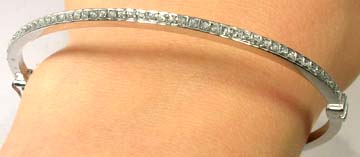
NEW Sterling Silver Fifty (50) Diamond-Accented Seven Inch Bracelet.
50 DIAMOND GEMSTONES: About 1mm each, total gemstone weight approximately 0.50 carats.
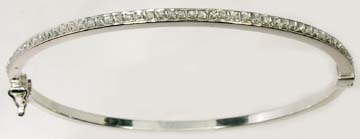
DETAIL: There was but one source of diamond in the ancient world…India, where written records pertaining to diamond date back to 400 B.C. The use of diamonds in Rome is established by the writings of the Roman Historian and Naturalist, Pliny the Elder (23-79 A.D.). The ancient Romans believed that diamonds were splinters of fallen stars. Aside from its use in jewelry, the Romans also used diamond points set into iron scribes to engrave sapphires, cameos, and intaglios. Even early Chinese references to diamond cite its coming from Rome in iron scribes. Chinese interest in diamonds was strictly as an engraving or carving tool, primarily for jade, or as a drill for beads and pearls. The ancient Greeks believed diamonds were tears of the gods; and it is from the Greek word adamas, "untameable" or "unconquerable", referring to its hardness, that the word “diamond” is derived. Celebrating our cultiral inheritance, here are fifty such “star splinters” mounted into an exceptionally nice and well constructed seven inch sterling silver hinged bracelet with a secure clasp. There are fifty (50) one millimeter diamonds mounted into the bracelet, and though they are small, they are of nice quality, and they are genuine diamonds (not man-made synthetic valueless fake gemstones). The bracelet is new, never worn.
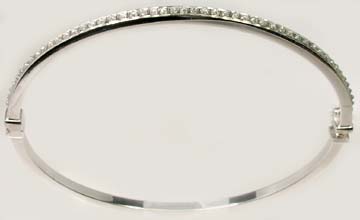
DIAMOND HISTORY: In the ancient world there was only one source of diamonds…India. Bombay remains today one of the world’s great diamond cutting centers (along with New York, Tel Aviv, and Antwerp). Over 800,000 cutters are employed in the city of Bombay alone; cutting 90% of the world’s diamonds. The best Indian diamonds originated from the Majhgawan pipe, near Panna, India, which was discovered in 1827. However India is no longer a big producer of mined diamonds, producing only about 20,000 carats a year.
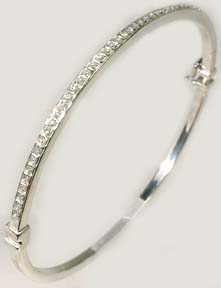
Australia produces 2,000 times more diamonds each year – about 40 million carats a year; followed by 20 million carats a year for the Congolese Republic, 15 million carats a year for Botswana, and 10 million carats a year each for Russia and South Africa. However this region of India did produce some of the world’s greatest diamonds, including the Great Mogul (793 carats), the Regent (410 carats), the Nizam (340 carats), the Orloff (194 carats), the Kohinoor (132 carats), and the Hope or Blue Tavernier (112 carats).

The traditional Indian supplies of diamonds which had fed the appetites of the ancient world for thousands of years were almost exhausted when enormous new alluvial deposits of diamonds were discovered in 1725 in Brazil, followed by the staggering discoveries of 1870 in South Africa. Perhaps the earliest symbolic use of diamonds was as the eyes of Hindu devotional statues. The diamonds themselves were thought to be endowments from the gods and were therefore cherished. The point at which diamonds assumed their divine status is not known, but early texts indicate they were recognized in India since at least 400 B.C.

The word most generally used for diamond in Sanskrit was vajra, or "thunderbolt," and the possession of diamond was according to ancient Hindu texts thought to bring, “happiness, prosperity, children, riches, grain, cows and meat. (As well) he who wears a diamond will see dangers recede from him whether he (is) threatened by serpents, fire, poison, sickness, thieves, flood or evil spirits." The ancient Greeks believed diamonds were tears of the gods; and it is from the Greek word adamas, "untameable" or "unconquerable", referring to its hardness, that the word “diamond” is derived. The ancient Romans believed that diamonds were splinters of fallen stars.

The presence of diamond in Rome is established by the writings of Pliny the Elder (23-79 A.D.). Unfortunately according to Pliny, “these stones are tested upon the anvil, and will resist the blow to such an extent as to make the iron rebound and the very anvil split asunder." One can only imagine the numbers of genuine diamonds smashed into splinters by this ill-advised test. However even diamond splinters were valued by the Romans who used diamond points set into iron scribes to engrave sapphires, cameos, and intaglios. Even early Chinese references to diamond cite its coming from Rome in iron scribes. Chinese interest in diamond was strictly as an engraving or carving tool, primarily for jade, or as a drill for beads and pearls.

In western culture, diamonds have been the traditional emblem of fearlessness and virtue. Though most of the world’s diamonds are cut in Bombay, over 90% of the world’s rough diamonds are traded in Antwerp, Belgium. Between the 13th and 15th centuries the world’s diamond center had been Bruges; then Antwerp until the city’s capture by the Spanish in 1585 A.D.; then Amsterdam through the early 19th century, then back to Antwerp. The Portuguese colony of Goa was the point of origin for diamonds from India, the trade route developing from Goa to Lisbon to Antwerp and thus cutting out the traditional Arabic middle men.

Small numbers of diamonds begin appearing in European regalia and jewelry in the 13th century, set as accent points among pearls in splendidly wrought gold. Louis IX of France (1214-70 A.D.) decreed that diamonds were to be reserved for royalty alone, an indication of the rarity of diamonds and the value conferred on them at that time. The history of diamond cutting can be traced to the late Middle Ages, before which time diamonds were enjoyed in their natural octahedral state. At the time, diamond was valued chiefly for its brilliant lustre and superlative hardness. The most common (“table”) cut diamond would appear black to the eye, as they do in paintings of the era.

Diamond cutting is believed to have originated in Venice about 1330 A.D. By 1375 A.D. there was a guild of diamond polishers in Nurnberg. About a hundred years later absolute symmetry in the disposition of faceting was introduced and the most common cuts were known as pendeloque or briolette. About the middle of the 16th century, the rose cut was introduced. The first “brilliant cut” was introduced in the middle of the 17th century. By the 16th century as diamonds became larger and more prominent, their popularity had spread from royalty to the noble classes. This was in part a response to the development of diamond faceting, which enhanced their brilliance and fire. By the 17th century diamonds were becoming popular with the wealthy merchant class.

Diamonds occur in a variety of colors - steel, white, blue, yellow, orange, red, green, pink, brown and black. The most common diamonds, and arguably the most sought after (though not the rarest) are pure and colorless. The most common impurity is nitrogen, which if dispersed will give the stone a yellowish tint (but if clustered does not affect the diamond’s color). Diamonds without nitrogen impurities are often colored pink, red, or brown – the color arising from molecular structural anomalies. Blue diamonds are colored by boron impurities. A form of carbon, diamonds are not “forever”, even the Romans demonstrated that they will burn (or decay with heat).
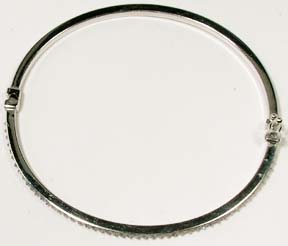
However a diamond is likely the oldest thing you will ever own, probably 3 billion years in age, fully two thirds the age of the Earth. Diamonds are carbon crystals that form deep within the Earth under high temperatures and extreme pressures. For instance when as part of “plate teutonics” an ocean floor slides beneath the earth’s crust and into the mantle, entrapped organic carbon may eventually become diamond. They are created at depths generally more than 150 kilometers down into the mantle. Diamonds are brought back to the surface in a rare form of molten rock (or magma), that originates at great depths, which rises and erupts in small but violent volcanoes. When cooled, just beneath such volcanoes is a carrot-shaped "pipe" filled with volcanic rock, mantle fragments, and embedded diamonds.

Diamonds also form as a result of the immense pressures created by meteor impacts. Meteorites also experience impacts themselves and can contain diamonds. And the most ancient meteorite material contains star dust, the remnants of the death of stars. Some of this star dust are very small diamonds and are older than the solar system itself. New studies indicate that they formed more than 5 billion years ago in flashes of radiation from dying red-giant stars into surrounding clouds of methane-rich gas. If you would like to learn more about diamonds, please click here to visit a great web site by the American Museum of Natural History.

Domestic shipping (insured first class mail) is included in the price shown. Domestic shipping also includes USPS Delivery Confirmation (you might be able to update the status of your shipment on-line at the USPS Web Site). Canadian shipments are an extra $15.99 for Insured Air Mail; International shipments are an extra $19.99 for Air Mail (and generally are NOT tracked; trackable shipments are EXTRA). ADDITIONAL PURCHASES do receive a VERY LARGE discount, typically about $5 per item so as to reward you for the economies of combined shipping/insurance costs. Your purchase will ordinarily be shipped within 48 hours of payment. We package as well as anyone in the business, with lots of protective padding and containers.

We do NOT recommend uninsured shipments, and expressly disclaim any responsibility for the loss of an uninsured shipment. Unfortunately the contents of parcels are easily “lost” or misdelivered by postal employees – even in the USA. If you intend to pay via PayPal, please be aware that PayPal Protection Policies REQUIRE insured, trackable shipments, which is INCLUDED in our price. International tracking is at additional cost. We do offer U.S. Postal Service Priority Mail, Registered Mail, and Express Mail for both international and domestic shipments, as well United Parcel Service (UPS) and Federal Express (Fed-Ex). Please ask for a rate quotation. We will accept whatever payment method you are most comfortable with. If upon receipt of the item you are disappointed for any reason whatever, I offer a no questions asked return policy. Send it back, I will give you a complete refund of the purchase price (less our original shipping costs).

We travel to Russia each year seeking antique gemstones and jewelry from one of the globe’s most prolific gemstone producing and cutting centers, the area between Chelyabinsk and Yekaterinburg, Russia. From all corners of Siberia, as well as from India, Ceylon, Burma and Siam, gemstones have for centuries gone to Yekaterinburg where they have been cut and incorporated into the fabulous jewelry for which the Czars and the royal families of Europe were famous for. My wife grew up and received a university education in the Southern Urals of Russia, just a few hours away from the mountains of Siberia, where alexandrite, diamond, emerald, sapphire, chrysoberyl, topaz, demantoid garnet, and many other rare and precious gemstones are produced. Though perhaps difficult to find in the USA, antique gemstones are commonly unmounted from old, broken settings – the gold reused – the gemstones recut and reset.

Before these gorgeous antique gemstones are recut, we try to acquire the best of them in their original, antique, hand-finished state – most of them centuries old. We believe that the work created by these long-gone master artisans is worth protecting and preserving rather than destroying this heritage of antique gemstones by recutting the original work out of existence. That by preserving their work, in a sense, we are preserving their lives and the legacy they left for modern times. Far better to appreciate their craft than to destroy it with modern cutting. Not everyone agrees – fully 95% or more of the antique gemstones which come into these marketplaces are recut, and the heritage of the past lost. But if you agree with us that the past is worth protecting, and that past lives and the produce of those lives still matters today, consider buying an antique, hand cut, natural gemstone rather than one of the mass-produced machine cut (often synthetic or “lab produced”) gemstones which dominate the market today.

Our interest in the fabulous history of Russian gemstones and the fabulous jewelry of the Czar’s led to further education and contacts in India, Ceylon, and Siam, other ancient centers of gemstone production and finishing. We have a number of “helpers” (family members, friends, and colleagues) in Russia and in India who act as eyes and ears for us year-round, and in reciprocity we donate a portion of our revenues to support educational institutions in Russia and India. Occasionally while in Russia, India, Siam, and Ceylon we will also find such good buys on unique contemporary gemstones and jewelry that we will purchase a few pieces to offer to our customers here in America. These are always offered clearly labeled as contemporary, and not antiques – just to avoid confusion. We can set most any antique gemstone you purchase from us in your choice of styles and metals ranging from rings to pendants to earrings and bracelets; in sterling silver, 14kt solid gold, and 14kt gold fill. When you purchase from us, you can count on quick shipping and careful, secure packaging. We would be happy to provide you with a certificate/guarantee of authenticity for any item you purchase from me. There is a $2 fee for mailing under separate cover. Please see our "ADDITIONAL TERMS OF SALE."


| |||||||||||||||||||||













